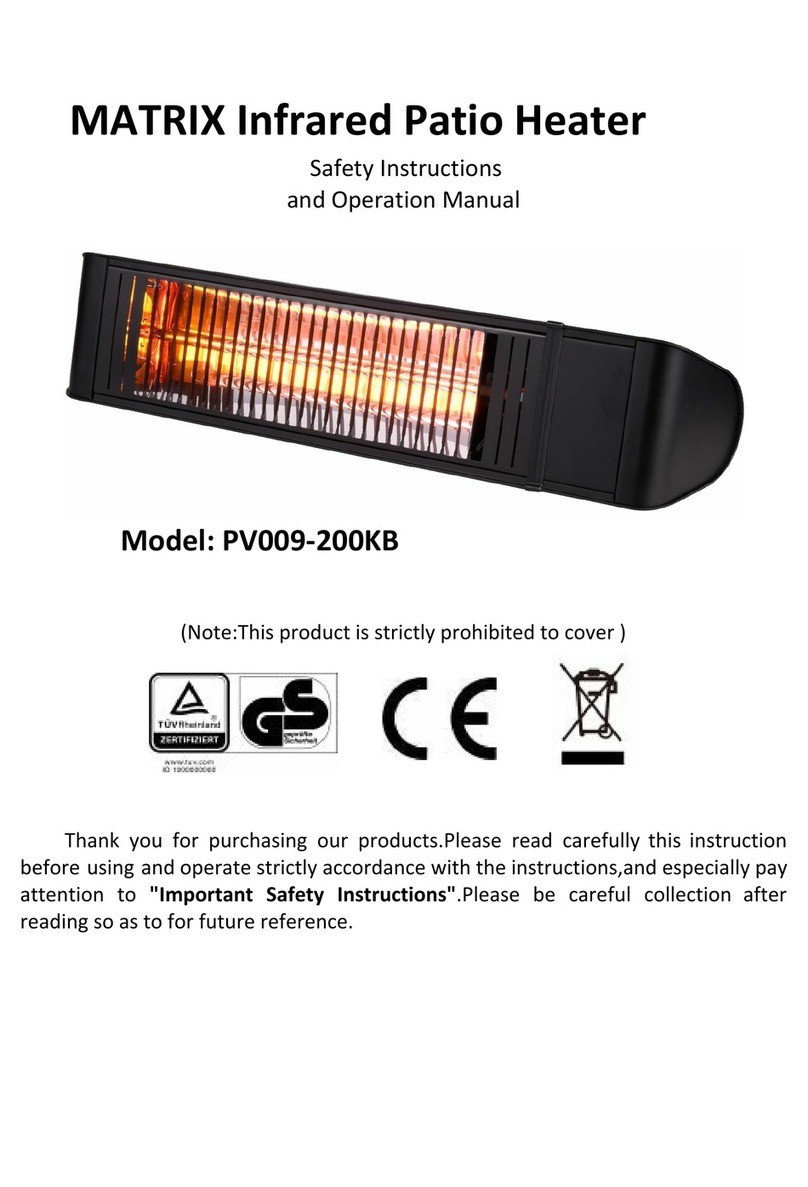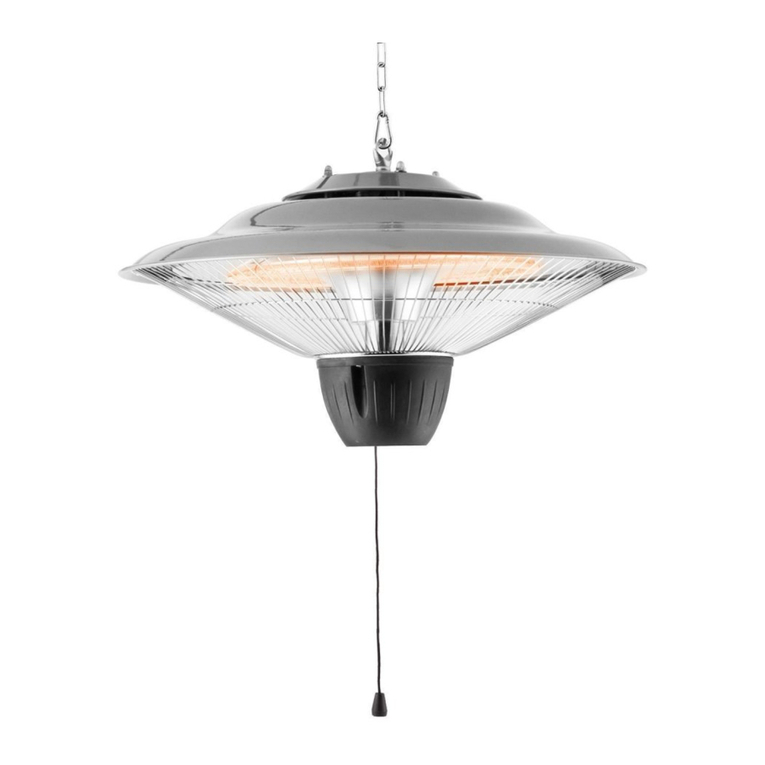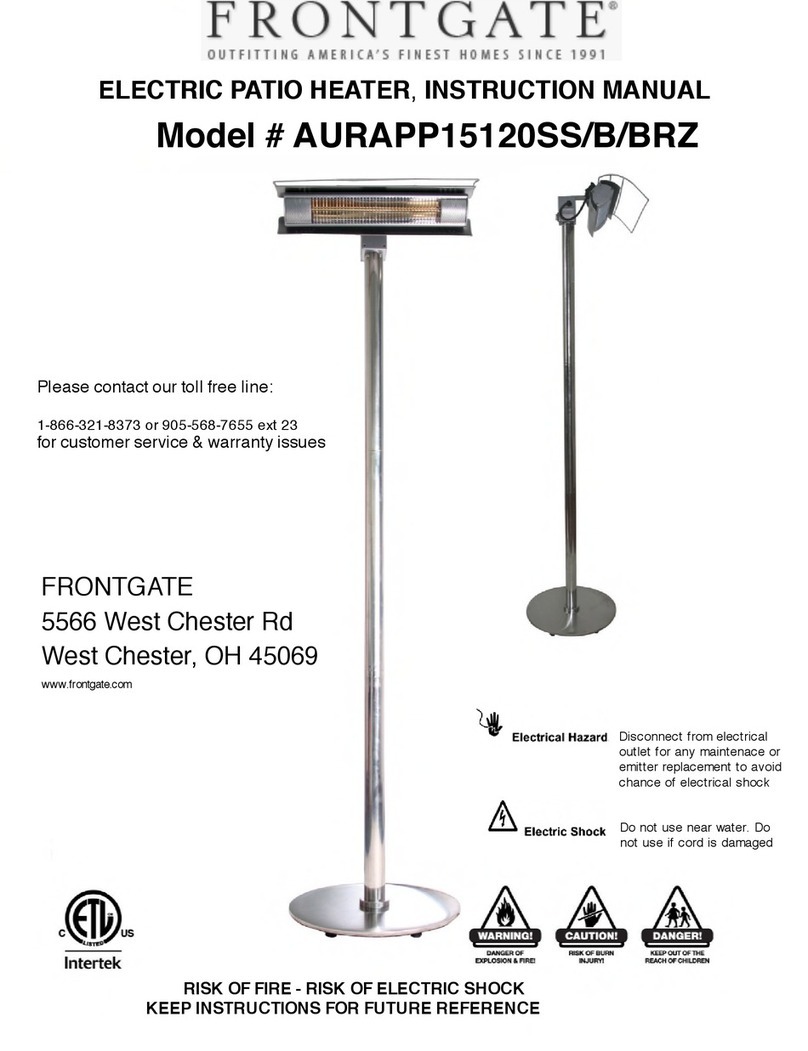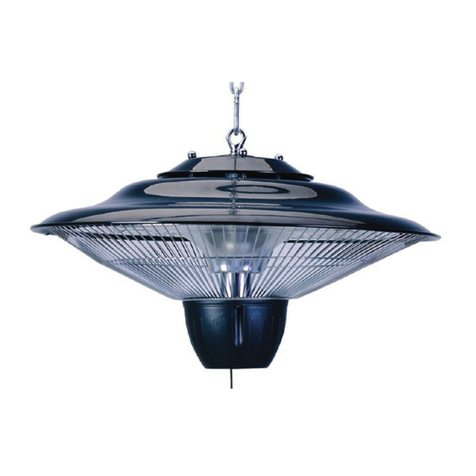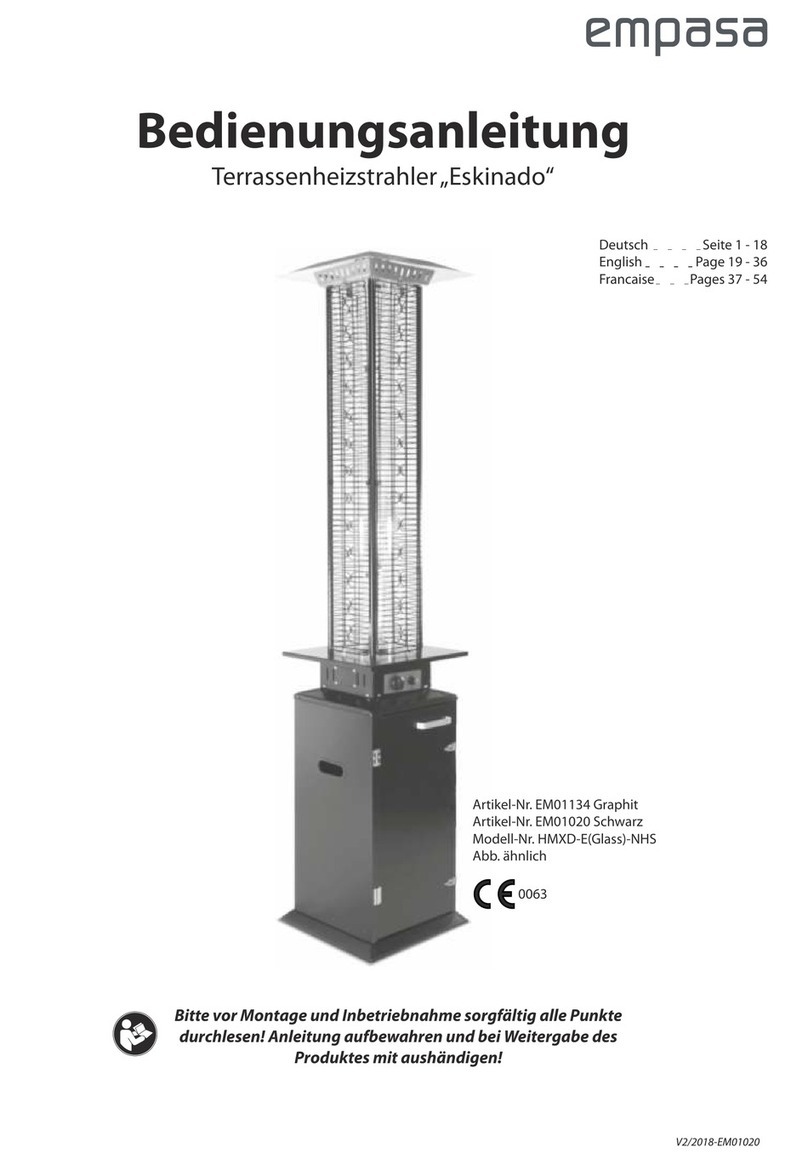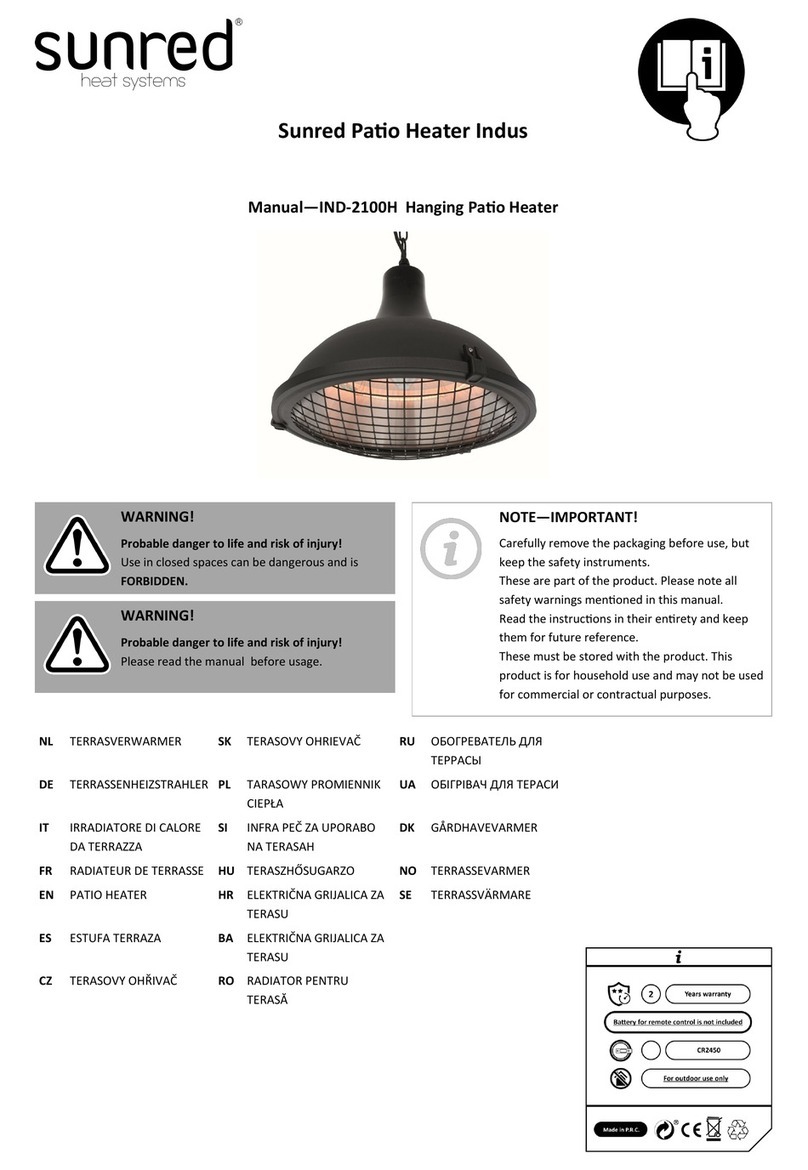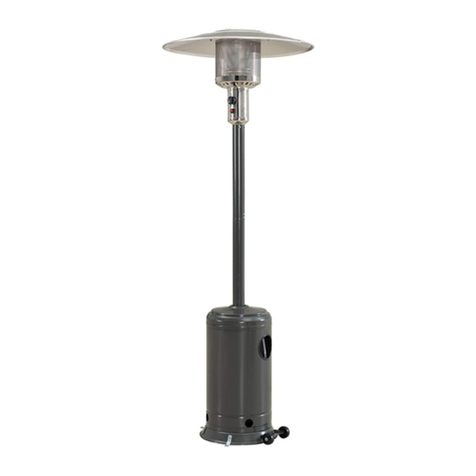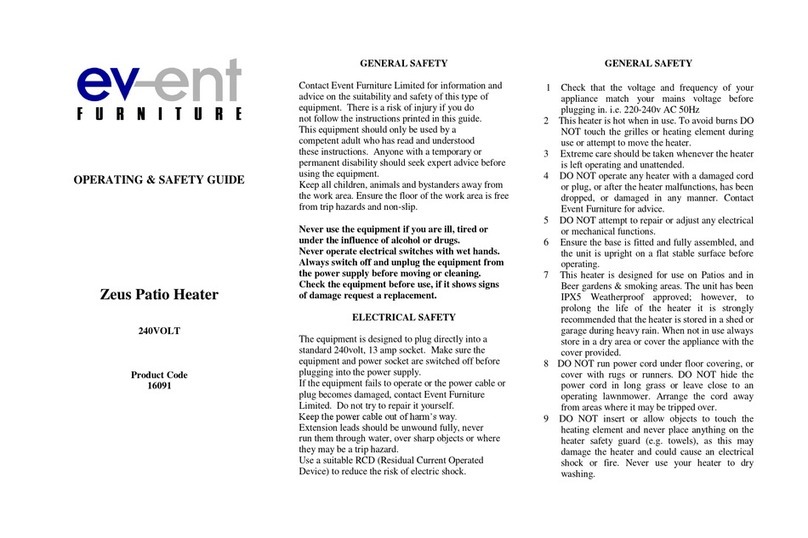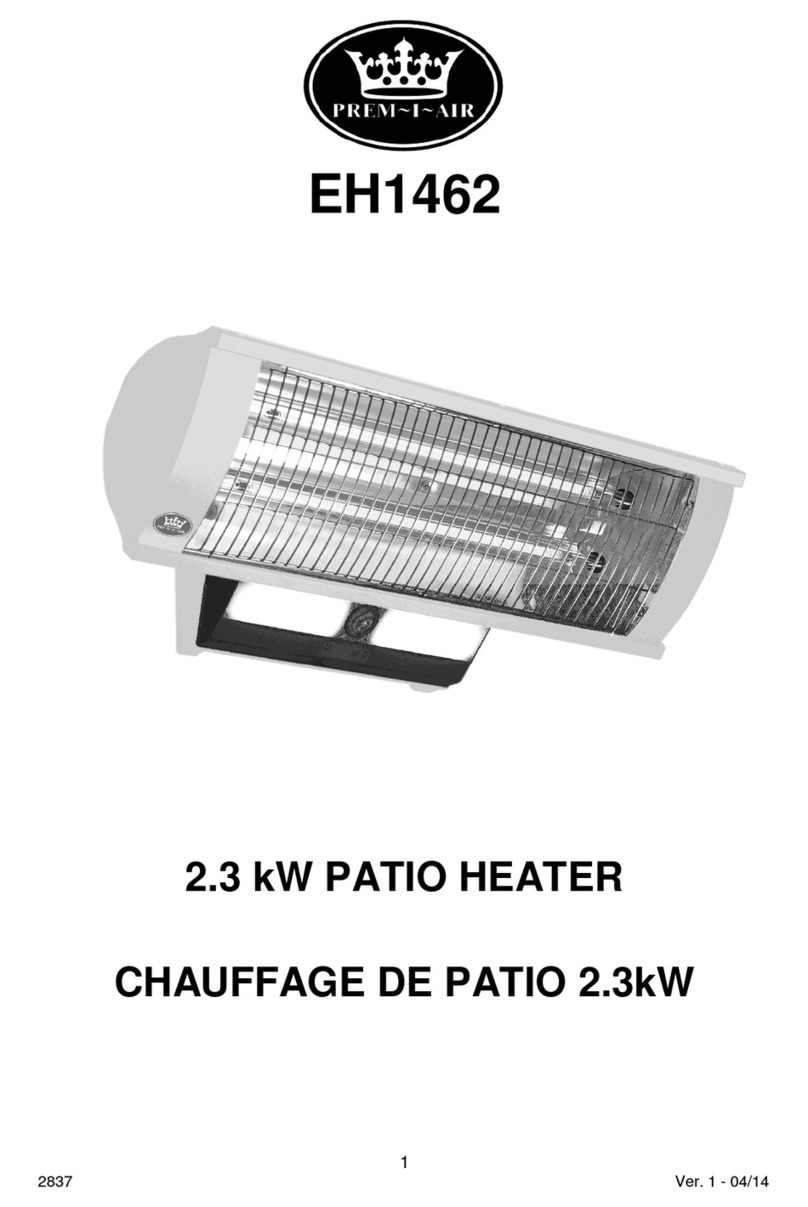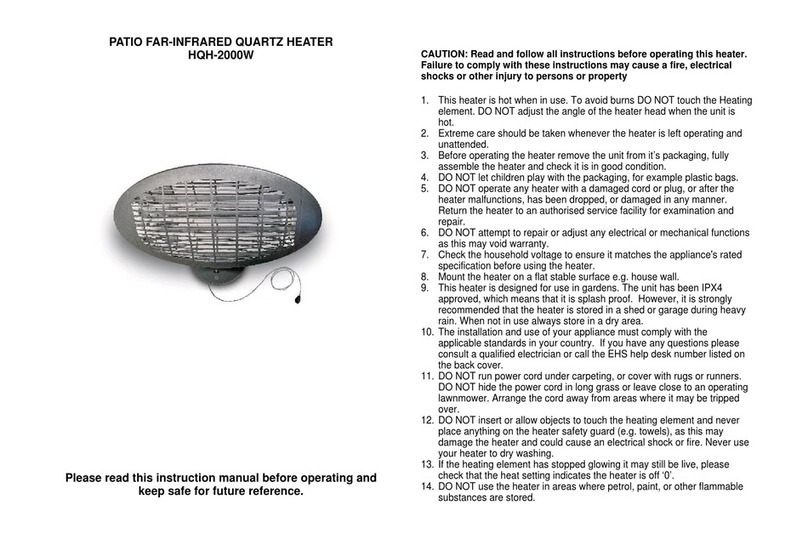
Need help? 1.800.762.1142
Do not return to place of purchase.
Replacement Parts
1.800.762.1142 9
10. Release control knob after 30 seconds. Pilot light will remain lit.
11. If ignition does not occur in 5 seconds, turn burner control knob to “ OFF,” wait 5 minutes,
fan with a newspaper or magazine, and repeat lighting procedure.
12. Turn control knob to (HIGH) (Figure 5). The burner should light immediately. Flame should
be visible through viewing hole. If not, turn control knob “ OFF,” turn burner control
knob to “ OFF,” wait 5 minutes, fan with a newspaper or magazine, and repeat lighting
procedure.
13. If igniter does not light burner:
a. Wearing heat-resistant gloves, position a long lit match or long lit butane lighter
through the pilot viewing hole near the pilot housing.
b. Push and turn control knob to (LOW/PILOT).
c. Remove match/lighter once burner is lit.
WWARNING: Be careful when attempting to manually ignite this heater.
Holding in the control knob for more than 10 seconds before igniting
the gas will cause a ball of flame upon ignition.
WCAUTION: If burner flame goes out during operation, IMMEDIATELY
turn the control knob to the “ OFF” position, LP gas tank valve
“CLOSED” and let the gas clear for 5 minutes before re-lighting.
14. After lighting, observe the burner flame. Make sure all burner ports are lit and flame height
matches illustration (Figure 7).
TIP: The burner may be noisy when initially lit. To eliminate excessive noise from the burner
turn the control knob to the (pilot) position, then turn the knob to the level of heat desired.
TIP: Remove manufacturing oils on this heater for the first time by operating the heater for at
least 15 minutes on (HIGH). This will “heat clean” the internal parts and dissipate odors.
When Heater is On
WWARNING: Dome and burner are extremely hot to the touch during
operation. NEVER touch the dome or burner while the heater is
operating. The surface of heater’s emitter can reach temperatures
approaching 1600ºF.
WWARNING: Do NOT touch metal parts of heater until they have
completely cooled to avoid burns, unless you are wearing protective
gear (pot holders, gloves, BBQ mittens, etc.).
• Emitter screen will become bright red due to intense heat. The color is more visible at
night.
• Burner will display tongues of blue and yellow flame. These flames should not be yellow or
produce thick black smoke, indicating an obstruction of airflow through the burners. The
flame should be blue with straight yellow tops (Figure 7).
• If excessive yellow flame is detected, turn off heater and visit BlueRhino.com for cleaning
instructions or call 1.800.762.1142.
WCAUTION: If burner flame goes out during operation, IMMEDIATELY
turn the control knob to the “ OFF” position, LP gas tank valve to
“CLOSED,” and let the gas clear for 5 minutes before re-lighting.
Re-lighting
Note: For your safety, the control knob cannot be turned the the “ OFF” position without first
depressing control knob in (LOW/PILOT) position and then rotating it to “ OFF.”
1. Turn control knob to “ OFF.”
2. Wait at least 5 minutes to let gas dissipate, fan with a newspaper or magazine.
3. Light per “Lighting” section.
Turning Off
1. Turn control knob clockwise to the (LOW/PILOT) position. Burner will extinguish but pilot
will remain “ON.”
2. Turn LP gas tank valve to “CLOSED.”
Note: A “poof” sound is normal as the last of the LP gas is burned.
3. Disconnect LP gas tank per “Disconnecting LP Gas Tank” section.
Note: After use, some discoloration of the emitter screen is normal.
Cleaning and Care
WCAUTION:
1. All cleaning and maintenance should be done when heater is cool
and with the fuel supply disconnected.
2. Do NOT clean any heater part in a self-cleaning oven. The extreme
heat will damage the finish.
3. Do NOT enlarge valve orifices or burner ports when cleaning the
valves or burners.
Notices
1. This heater should be thoroughly cleaned on a regular basis.
2. Abrasive cleaners will damage this product.
3. NEVER use oven cleaner to clean any part of heater.
4. More frequent cleaning may be required as necessary. It is imperative that control
Operating Instructions
Checking for Leaks
WWARNING: Before using this outdoor
fireplace, make sure you have read,
understand and are following all
information provided in the “Important
Safeguards” section. Failure to follow
those instructions can cause death,
serious injury or property damage.
Tank/Gas Line Connection
1. Make 2-3 oz. of leak detection solution by mixing
one part liquid dishwashing soap with three parts
water.
2. Make sure control knob is in the “ OFF” position
(Figure 3).
3. Connect LP gas tank per “Installing LP Gas Tank”
section.
4. Turn LP gas tank valve to “OPEN.”
5. Spoon several drops of solution, or use a squirt
bottle, at all “X” locations (Figures 1 and 2).
a. If any bubbles appear, turn LP gas tank valve to
“CLOSED,” reconnect and re-test.
b. If you continue to see bubbles after several
attempts, turn LP gas tank valve to “CLOSED”
and disconnect LP gas tank, per “Disconnecting
LP Gas Tank” section. Contact 1.800.762.1142
for assistance.
c. If no bubbles appear after one minute, turn
LP gas tank valve to “CLOSED,” wipe away
solution and proceed.
Lighting
WWARNING: NEVER light the burner with
the cover on the heater.
WCAUTION: Keep outdoor gas appliance
area clear and free from combustible
materials, gasoline and other
flammable vapors and liquids.
WCAUTION: Do NOT obstruct the flow of
combustion and ventilation air.
WCAUTION: Check and clean burner/
venturi tubes for insects and insect
nests. A clogged tube can lead to a
fire.
WCAUTION: If relighting a hot heater,
always wait at least 5 minutes before
relighting.
Note: This heater is equipped with a pilot light that
allows for safer startups and shutdowns. Pilot must be
lit before main burner can be started.
Note: For your safety, the control knob cannot be
turned to the “ OFF” position without first depressing
control knob in (LOW/PILOT) position and then
rotating it to “ OFF.”
1. Make sure all labels, packaging and protective
films have been removed from the patio heater.
2. Check for obstructions of airflow to the burners.
Spiders, insects and webs can clog the burner/
venturi tube. A clogged burner tube can lead to
a fire.
3. Control knob must be in the “ OFF” position
(Figure 3).
4. Connect LP gas tank per “Installing LP Gas Tank”
section.
5. Perform leak check per “Checking for Leaks”
section.
6. Turn LP gas tank valve to “OPEN.”
7. Open viewing hole by sliding cover to either side
(Figure 6).
8. Push control knob in and rotate to (LOW/PILOT)
position (Figure 4). For initial start or after any
tank change:
a. Hold control knob in for 2 minutes to purge
air from gas lines before proceeding
b. Then wait 5 minutes before lighting heater.
9. Immediately push (igniter) button for five (5)
seconds. Pilot light flame will appear and be
visible through viewing hole (Figure 6).
compartment, burners and circulating air passageways of the heater be kept clean.
5. Have heater inspected annually. Repairs should be made by a qualified service
person.
6. Inspect heater before each use.
7. Spiders and insects can create a dangerous condition that may damage the heater
or make it unsafe. Keep burner area clean of all spiders, webs and insects. Clean
burner holes by using a heavy-duty pipe cleaner. Compressed air may help clear
away smaller particles.
8. Check heater immediately if any of the following conditions exist:
a. You smell gas in conjunction with extreme yellow tipping of burner flames.
b. Heater does not reach proper temperature.
Note: At temperatures less than 40ºF, heat output will be reduced.
c. Heater’s glow is excessively uneven.
d. Burner makes popping noises during use.
Note: A “poof” sound is normal as the last of the LP gas is burned.
9. Carbon deposits may create a fire hazard. Keep dome and emitter clean at all times.
10. Do NOT clean heater with combustible or corrosive cleaners. Use warm, soapy water.
11. Do NOT paint engine, engine access panel or dome.
12. After a period of storage and/or non use, check for leaks, burner obstructions and
inspect for any abrasion, wear or cuts to the hose.
13. Check under the dome and engine area periodically for any obstructions such as
spiderwebs, bird nests, etc.
Before Each Use
1. Keep the heater area clean and free from any combustible materials, gasoline, and other
flammable vapors and liquids.
2. Do NOT obstruct the flow of the combustion of LP gas and the ventilation of air.
3. Keep the ventilation opening(s) of the LP gas tank area free and clear from debris.
4. Visually check the burner flames to make sure your heater is working properly (Figure 7).
5. See sections below for proper cleaning instructions.
6. Check all gas connections for leaks.
7. Check components for any signs of damage or rust.
8. Check for obstructions of airflow to the burner. Spiders, insects and webs can clog the
burner/venturi tube. A clogged burner/venturi tube can lead to a fire.
9. If damage to any component is detected, do NOT operate until repairs are completed.
Cleaning Surfaces
1. Wipe surfaces clean with mild dishwashing detergent or baking soda mixed with water.
2. For stubborn stains, use a citrus-based cleaner and a nylon scrubbing brush.
3. Rinse clean with water.
4. Allow to air dry.
Note: While cleaning your unit, be sure to keep the area around the burner and pilot assembly
dry at all times.
WCAUTION: While cleaning your unit, be sure to keep the area around
the burner and pilot assembly dry at all times.
WCAUTION: Do NOT submerge the control valve assembly. If the gas
control is submerged in water, do NOT use it. It must be replaced.
Maintenance
To enjoy years of outstanding performance from your heater, make sure you perform the
following maintenance activities on a regular basis:
1. Keep exterior surfaces clean.
2. Perform routine maintenance.
3. Air flow must be unobstructed. Keep controls, burner, and circulating air passageways
clean. Signs of possible blockage include:
• Gas odor with extreme yellow tipping of flame.
• Heater does NOT reach the desired temperature.
• Heater glow is excessively uneven.
• Heater makes popping noises.
Note: In a salt-air environment (such as near an ocean), corrosion occurs more quickly than
normal. Frequently check for corroded areas and repair them promptly.
TIP: Use high-quality automobile wax to help maintain the appearance of your heater. Apply to
exterior surfaces from the pole down. Do NOT apply to emitter screen or domes.
Storage and Transporting
1. Turn off per “Turning Off” section.
2. Clean all surfaces per “Cleaning Surfaces” section.
3. Cover the patio heater with a patio heater cover to help protect from the weather and
build up in air passages.
WWARNING: Wait until heater is cool before covering.
4. Store heater upright in an area sheltered from direct contact with inclement weather (such
as rain, sleet, hail, snow, dust, debris and high winds).
5. Place the protective cap cover on the LP tank and store the tank outdoors in a well
ventilated area out of direct sunlight.
Cleaning and Care (continued)


